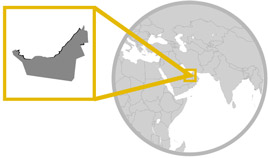Religion
With over half the population following the Ibadi sect, around 75% of Omani residents are Muslim. However, there are also a significant number of Christians, Hindus and Sikhs living in the country and there has been progress in constructing a Sikh Gurudwara and two Hindu temples, one being over a hundred years old, as well as many Christian Churches and sites. Additionally, a fair few Muslims are members of the Sunni sect and although freedom of religion is widely advocated within the region, all sites of worship must be government approved.
 Museums, Galleries & Architecture
Museums, Galleries & Architecture
Museums and galleries in Oman are few in number but high in quality with most of the major cities owning at least one museum. These include the Muscat Gate Museum which details Oman’s history in depth from Neolithic times to the present day, the Museum of Omani Heritage which contains archaeological objects and information pertaining to the development of architecture, agriculture, minerals, firearms and arts in the region, and the Oman Natural History Museum which details the natural history, fauna, flora and geographical shifts of the region.
Traditional architecture in the region has been ecologically to work in an environmentally friendly way such as lacking air conditioners but being built in such a way that the natural air currents sweep through the house and keep it cool during the blazingly hot summer months. It typically follows a very Arabian style and through influences with the surrounding areas incorporates light colours on the exterior to help reflect the sunlight whilst using detailed interiors for truly interesting patterns, designs and imagery.
 Clothing, Dress Style & Etiquette
Clothing, Dress Style & Etiquette
Traditional dress in Oman for men features the Dishdasha (an ankle-length long-sleeved collarless gown, usually white but sometimes brown, lilac or black) and the Muzzar (a type of turban). It’s also common to carry an Assa (a type of cane) and/or a Khanjar (a curved dagger used for formal occasions).
Female wear includes the Abaya (a black dress), the Hijab (a hair covering), the Sirwal (a dress worn over trousers), the Lihaf (a headdress) and either sandals or, more rarely, a type of wooden platform shoe. It’s also common for women to wear jewelry and cosmetic items.
Literature, Poetry, Music & Dance
Over the course of history the country of Oman has been influenced musically by Portugal, Iran, Tanzania, Yemen, Egypt, Saudi Arabia and the United Arab Emirates, as well as many other Western Influences. Music is played and danced to by men, women and children for what is considered to be the biggest moments of the Omani lifestyle such as Birth, Circumcision, Marriage and Death. Traditional music and dance include the Liwa (an originally African dance performed in a circle to drums and reed-based wind instruments) and the Fann At-Tanbura (a Persian dance performed to a small stringed instrument).
Commonly used instruments include the Tanbura (a type of lyre or lute), the Mizmar (a type of single or double reed wind instrument) and the Zurna (another type of reed wind instrument). Often singing is performed in other languages such as Swahili for dances and events.
The literary history in Oman dates back to the 9
th Century and features works such as Abu al-Muthir al-Salt al-Bahlawi’s al-Siya al-Umaniya (Omani Lives) in the 9
th Century, Salama al-Awtabi’s Ansab al-Arab (Arab Genealogies) in the 11
th Century and Oman Sirhan ibn Said’s Kashf al-Ghumma (Annals of Oman) in the 19
th Century. The country also enjoys a whole host of contemporary Arabic poetry from famed authors such as Muhammad Amin Abdullah, Mahmud al-Khusaybi, Sheikh Abdullah bin Ali al-Khalili, Hilal bin Badr, Abu Surur Humayd al-Jamii and Abdullah al-Taiey.
Calendar & Events
Oman’s first public holiday sets in on January 1
st with New Years’ day. Following this, Mohammed’s birthday is celebrated on Milad Al Nabi on January 14
th. Then in May 26
th, Mohammed’s ascension is celebrated on Al Israa Wal Miraj. July 23
rd is Renaissance Day and then finally, between July 28
th and July 31
st Eid al Fitr, the end of Ramadan, is celebrated.



